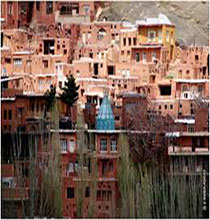Abyaneh jame mosque
Jame mosque of Abyaneh is located on north-west of karkas Mountain and 28 km far from Natanz City. The oldest building of Abyaneh is Abyaneh jame mosque that is repaired many times. Abyanah is a remote village in a valley of the Karkas Mountains where wood is relatively plentiful, and it is the primary construction material of the mosque.

Description of Abyaneh Jame Mosque
The most famous monument of Abyaneh is an 11th-century Jameh Mosque that is one of the 11 mosques are considered historic. This beautiful mosque made up of two Shabestan (It is part of a large mosque with a roof), which located in the middle part of the Miyan Deh city. One of the oldest pieces of this village is the altar made of wood and placed on the southern side of this Shabestan, during the rule of Seljuqi.
It is not certain who patronized the construction of the Abyaneh Jame Mosque, although a recorded restoration period undertaken in 1322 is attributed to a Mawlana 'Izz-al-din bin Muhammad Baha-al Din. Dated from the Seljuk period, when brick was the preferred construction material, this is a rare example of the use of wood in the construction of a mosque. The sanctuary of the mosque has a wooden mihrab, It is the only wooden mihrab in Iran that has survived from Seljuk date.
Architecture of Abyaneh Mosque
This mosque has a hypostyle type layout with a flat roof and wooden columns. There are two octagonal shaped wooden columns on either side of the mihrab axis. These are topped by square capitals with projecting brackets that are carved with floral motifs. There are a number of inscriptions and a manbar (pulpit) in the mosque. The interesting thing is that the pulpit has many features similar to the architectural elements and column heads seen in Persepolis
A wooden mihrab is found in the sanctuary of the Abyaneh Mosque which is flanked with carvings of various patterns in wood and a chapter from the Quran. A date inscribed on it reveals that it dates from the fourteenth century. It is the only recorded example in Iran of a mosque with a wood mihrab. Built by the order of Abu Ja'far Mohamed in 1084-85, it measures approximately 2 by 1.08 meters. A wooden minbar, originally built in 1073-1074 and restored numerous times, can also be found in the interior of the mosque. It is extensively decorated with carvings of both inscriptions and floral motifs. The wood surfaces of the ceiling are also carved with floral and geometric motifs, as well as painted with floral designs.